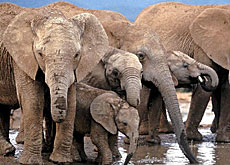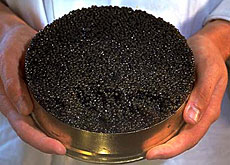Swiss find ways to survive caviar ban

There may be a ban on the global trade in caviar, but Switzerland is not about to give up on the rich man's delicacy.
Some Swiss companies have been stocking up ahead of the ban, while there are also plans to open the country’s first sturgeon farm.
The six-month stoppage is aimed at protecting dwindling stocks of wild sturgeon in the Caspian Sea region, which supplies 90 per cent of the world’s caviar.
It was imposed by the Geneva-based Convention on International Trade in Endangered Species, Cites, whose members feared that proposed quotas for 2006 did not fully reflect the reduction in stocks or make sufficient allowance for illegal fishing.
Countries sharing sturgeon stocks must now agree among themselves on catch and export quotas based on scientific surveys of the stocks. Traders must ensure that all imports are from legal sources.
Roe to ruin?
Switzerland is a major importer of caviar, which is made from the unfertilised eggs from one of 27 species of sturgeon.
Imports amount to SFr15 million ($12 million) per year, and the most expensive variety – Iranian Beluga – costs SFr8,000 – SFr9,000 per kilo.
One of the country’s largest traders, Hugo Dubno, in the northern Swiss town of Henschiken, anticipated the ban and stocked up before it came into force in January 2006.
Director Raphael Lenherr believes they have enough of the briny delicacy to see them through to June, after which, he hopes, it will be business as usual.
“We are convinced that our producers will get their licences back to provide caviar for the second half of the year,” he told swissinfo.
As Caspian stocks decline, caviar from European fish farms is gaining popularity.
Hugo Dubno was one of the first companies to start importing Osetra caviar from France.
“Connoisseurs will argue that the Caspian caviar is the finest, but caviar from sturgeon bred in captivity is just as good,” Lenherr explained.
At the moment fish farm caviar from France is 20 per cent cheaper than wild sturgeon caviar, but Lenherr expects prices to rise as Caspian sturgeon becomes more rare.
There are now plans to set up the first Swiss sturgeon farm in Frutigen, in the Bernese Alps.
Frutigen fruit
It could owe its existence to the 34.6km Lötschberg rail tunnel, which is due to be completed at the end of 2007.
It’s the longest tunnel in the Alps, and one of the biggest engineering projects in the world.
The tunnel discharges between 150 and 200 litres per second of warm water from an underground spring into the River Kander in Frutigen, presenting a possible danger to indigenous fauna and flora.
When the tunnel is finished, the government insists that the discharged water, with a temperature of between 18 and 22 degrees, must be artificially cooled before entering the river.
Local residents do not want to waste this free source of energy, so they welcomed a project by the engineering firm, Emch + Berger, to use it for the production of tropical fruits and fish – and caviar.
It envisages that the warm water will heat a giant green house growing papayas, bananas and cumquat, and fill tanks stocked with African tilapia fish.
It will also pour into outside tanks containing sturgeon.
A caviar production centre will be opened, where tourists can watch the process through a glass screen. It is hoped that the first Swiss-bred caviar will be harvested in autumn 2006.
Investors are still being sought for the €10 million ($12.27 million) project.
Emch + Berger Director Peter Hufschmied told swissinfo he expects to secure the funding by May this year, and planning permission by the beginning of 2007.
Exotic Idea
Osetra and Sevruga sturgeon take between six and eight years to reach maturity, and Beluga sturgeon have to be at least 13 years old before their eggs can be harvested, so breeding the fish requires long term planning and funding.
Hufschmied has no doubts that they will be able to breed many different species.
“We are working with the best sturgeon experts in the field,” he told swissinfo.
There are two pilot projects underway to establish the suitability of the tunnel water, both for breeding Siberian and Beluga sturgeon and for heating the greenhouse.
Scientists from Bern University are also experimenting with different types of fish food.
If the ‘Tropenhaus’ goes ahead, it will provide employment for between ten and 20 local people, and generate revenue from tourism.
Most of the produce will be sold to visitors and local restaurants.
swissinfo, Julie Hunt
The sturgeon, a species as ancient as the dinosaur, can live for a century and grow to 25 feet (7.6 metres).
The Caspian Sea beluga sturgeon population has decreased by 90 per cent in 20 years due to overfishing.
Beluga caviar can cost up to SFr9,000 ($7,133) per kilo.
Switzerland imports SFr15 million worth of caviar each year.

In compliance with the JTI standards
More: SWI swissinfo.ch certified by the Journalism Trust Initiative












You can find an overview of ongoing debates with our journalists here . Please join us!
If you want to start a conversation about a topic raised in this article or want to report factual errors, email us at english@swissinfo.ch.